Cookie Consent
We use cookies to help provide a better website experience for you, and help us to understand how people use our website. Our partners will also collect data and use cookies for ad personalisation and measurement.
Clicking "Accept" will allow us and our partners to use cookies, learn more in our cookie policy or to change your cookie preferences, click "Manage".
To find out more about cookies and the types of cookies we are setting please visit our cookie policy .
If you'd prefer that certain types of cookie are not saved on your browser when visiting our website, use the toggles below to adjust those preferences and click "Save choices".

Strictly Necessary
These cookies are necessary for the website to function and without them you would not be able to reliably use the website. For example, logging into your account or completing forms.
Analytics Cookies
A series of cookies that collect anonymised data on how users interact with our website. This anonymous data helps us improve the website with a focus on its users, for example, ensuring the most popular content is easier to access.
View associated providers +
Marketing Cookies
These cookies track your online activity to help advertisers deliver more relevant and personalised advertising or to limit how many times you see an ad. These cookies can share that information with other organisations or advertisers.

I See Problem-Solving - UKS2
The ebook i see problem-solving - uks2 helps all children to learn how to solve multi-step maths questions. questions are broken down step-by-step and represented visually to build understanding, whilst extension tasks and reasoning prompts allow children to explore ideas at greater depth. the ultimate resource for teaching problem-solving in y5/6.

I See Problem-Solving - UKS2 Sample provides 5 free sample tasks. For each task there is a main question , a support prompt and explain and extend features to deepen the challenge. The worked examples model the solutions to the main tasks step-by-step - download below for free. The 58 tasks span all areas of the UKS2 maths curriculum. The purchase price is £30 (£25 + £5 VAT) for the PDF digital download.
I See Problem-Solving - UKS2: Worked Examples (PowerPoint)
I See Problem-Solving - UKS2: Worked Examples (PDF)
In these blogs I explain how the task prompts provide extra scaffold to give children additional help , and how extra layers of challenge can be added. Each task starts with a main question, like the examples below:

Children can use the support prompt if they need some extra help to answer the main question. The support prompt may give a suggested starting point, represent the question visually or address a possible misconception. It helps children to understand and access the task. Here are the support prompts for the above examples:
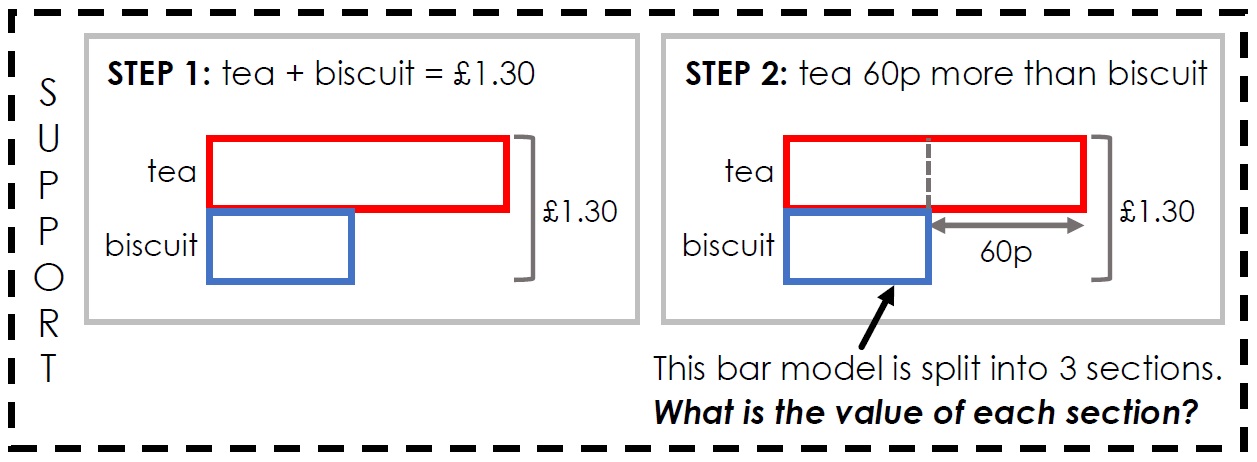
The explain features then provide an opportunity for children to reason based on the initial task. Prompts may ask children to explain a mistake, spot a pattern or make a link with a similar question. Children have to explain their opinion, deepening their understanding of the main question.

The extend feature gives a more challenging, related question for the children to solve. The mathematical structure of these tasks are similar to the initial prompt, usually with one added layer of complexity. Extend tasks may require children to make a generalisation, think laterally or find all possible answers to a question.
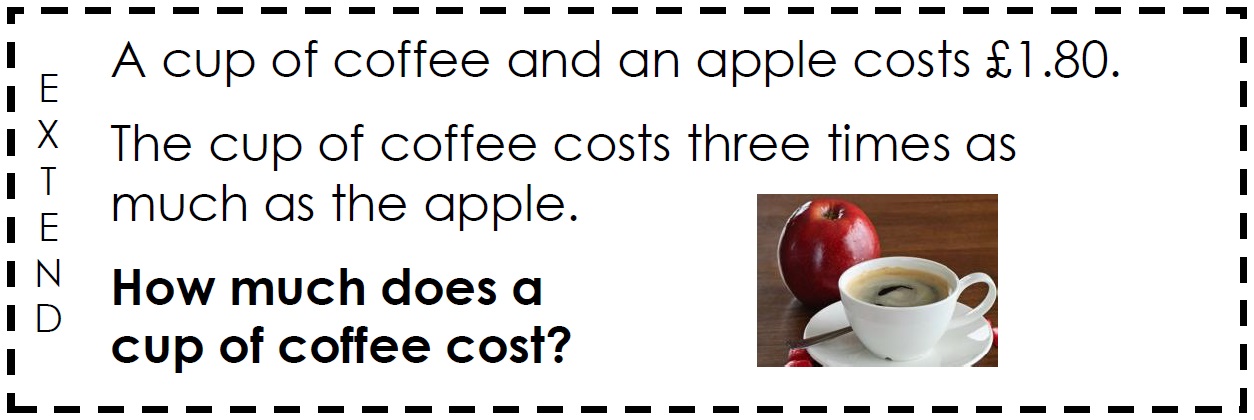
The 58 tasks of I See Problem-Solving - UKS2 cover all areas of the UKS2 curriculum. It corresponds to US grade 4&5 and Australian school years 5&6. The sale price is £30. When ordered, the PDF file is emailed direct to your inbox for your use.
To purchase, click on the link below. If you need assistance ordering, please read the Frequently Asked Questions below or email [email protected].

Or search by topic
Number and algebra
- The Number System and Place Value
- Calculations and Numerical Methods
- Fractions, Decimals, Percentages, Ratio and Proportion
- Properties of Numbers
- Patterns, Sequences and Structure
- Algebraic expressions, equations and formulae
- Coordinates, Functions and Graphs
Geometry and measure
- Angles, Polygons, and Geometrical Proof
- 3D Geometry, Shape and Space
- Measuring and calculating with units
- Transformations and constructions
- Pythagoras and Trigonometry
- Vectors and Matrices
Probability and statistics
- Handling, Processing and Representing Data
- Probability
Working mathematically
- Thinking mathematically
- Mathematical mindsets
- Cross-curricular contexts
- Physical and digital manipulatives
For younger learners
- Early Years Foundation Stage
Advanced mathematics
- Decision Mathematics and Combinatorics
- Advanced Probability and Statistics
Working Systematically at KS2 - Primary Teachers
This page has been superseded by our Working Systematically - Primary Teachers page
Scroll down to see our complete collection of KS2 problems that require children to work systematically, or explore the two sub-collections focusing on important aspects of systematic working.
This collection is one of our Primary Curriculum collections - tasks that are grouped by topic.
Finding All Possibilities Upper Primary
These activities focus on finding all possible solutions so working in a systematic way will ensure none are left out.
Ordered Ways of Working Upper Primary
These activities lend themselves to systematic working in the sense that it helps to have an ordered approach.
Sitting Round the Party Tables
Sweets are given out to party-goers in a particular way. Investigate the total number of sweets received by people sitting in different positions.
Beads and Bags
How could you put these three beads into bags? How many different ways can you do it? How could you record what you've done?
What could the half time scores have been in these Olympic hockey matches?
School Fair Necklaces
How many possible symmetrical necklaces can you find? How do you know you've found them all?
Nine-pin Triangles
How many different triangles can you make on a circular pegboard that has nine pegs?
Five More Coins
Could Ben have any amount of money between 5p and £2 in his pocket if he has five coins?
What Do You Need?
Four of these clues are needed to find the chosen number on this grid and four are true but do nothing to help in finding the number. Can you sort out the clues and find the number?
A Mixed-up Clock
There is a clock-face where the numbers have become all mixed up. Can you find out where all the numbers have got to from these ten statements?
Fifteen Cards
Can you use the information to find out which cards I have used?
Guess the Dominoes
This task depends on learners sharing reasoning, listening to opinions, reflecting and pulling ideas together.
Greater Than or Less Than?
Use the numbers and symbols to make this number sentence correct. How many different ways can you find?
Can you put the numbers 1-5 in the V shape so that both 'arms' have the same total?
Coded Hundred Square
This 100 square jigsaw is written in code. It starts with 1 and ends with 100. Can you build it up?
Multiply Multiples 1
Can you complete this calculation by filling in the missing numbers? In how many different ways can you do it?
Buying a Balloon
Lolla bought a balloon at the circus. She gave the clown six coins to pay for it. What could Lolla have paid for the balloon?
Round the Dice Decimals 1
Use two dice to generate two numbers with one decimal place. What happens when you round these numbers to the nearest whole number?
Can you replace the letters with numbers? Is there only one solution in each case?
A Square of Numbers
Can you put the numbers 1 to 8 into the circles so that the four calculations are correct?
Cubes Here and There
How many shapes can you build from three red and two green cubes? Can you use what you've found out to predict the number for four red and two green?
First Connect Three
Add or subtract the two numbers on the spinners and try to complete a row of three. Are there some numbers that are good to aim for?
Finding Fifteen
Tim had nine cards each with a different number from 1 to 9 on it. How could he have put them into three piles so that the total in each pile was 15?
Four bags contain a large number of 1s, 3s, 5s and 7s. Can you pick any ten numbers from the bags so that their total is 37?
Through the Window
My local DIY shop calculates the price of its windows according to the area of glass and the length of frame used. Can you work out how they arrived at these prices?
All the Digits
This multiplication uses each of the digits 0 - 9 once and once only. Using the information given, can you replace the stars in the calculation with figures?
Choose four different digits from 1-9 and put one in each box so that the resulting four two-digit numbers add to a total of 100.
Light the Lights Again
Each light in this interactivity turns on according to a rule. What happens when you enter different numbers? Can you find the smallest number that lights up all four lights?
This Pied Piper of Hamelin
Investigate the different numbers of people and rats there could have been if you know how many legs there are altogether!
Two Primes Make One Square
Can you make square numbers by adding two prime numbers together?
Sealed Solution
Ten cards are put into five envelopes so that there are two cards in each envelope. The sum of the numbers inside it is written on each envelope. What numbers could be inside the envelopes?
Prison Cells
There are 78 prisoners in a square cell block of twelve cells. The clever prison warder arranged them so there were 25 along each wall of the prison block. How did he do it?
Display Boards
Design an arrangement of display boards in the school hall which fits the requirements of different people.
Button-up Some More Live
How many ways can you find to do up all four buttons on my coat? How about if I had five buttons? Six ...?
The Dice Train
This dice train has been made using specific rules. How many different trains can you make?
Curious Number
Can you order the digits from 1-3 to make a number which is divisible by 3 so when the last digit is removed it becomes a 2-figure number divisible by 2, and so on?
Counting Cards
A magician took a suit of thirteen cards and held them in his hand face down. Every card he revealed had the same value as the one he had just finished spelling. How did this work?
Cover the Tray
These practical challenges are all about making a 'tray' and covering it with paper.
5 on the Clock
On a digital clock showing 24 hour time, over a whole day, how many times does a 5 appear? Is it the same number for a 12 hour clock over a whole day?
Ribbon Squares
What is the largest 'ribbon square' you can make? And the smallest? How many different squares can you make altogether?
The Remainders Game
Play this game and see if you can figure out the computer's chosen number.

Factor Lines
Arrange the four number cards on the grid, according to the rules, to make a diagonal, vertical or horizontal line.
Place the 16 different combinations of cup/saucer in this 4 by 4 arrangement so that no row or column contains more than one cup or saucer of the same colour.
This cube has ink on each face which leaves marks on paper as it is rolled. Can you work out what is on each face and the route it has taken?
- Primary Hub
- Art & Design
- Design & Technology
- Health & Wellbeing
- Secondary Hub
- Citizenship
- Primary CPD
- Secondary CPD
- Book Awards
- All Products
- Primary Products
- Secondary Products
- School Trips
- Trip Directory
- Trips by Subject
- Trips by Type
- Trips by Region
- Submit a Trip Venue
Trending stories

Top results

- Ks2 Maths Polya Problem Solving
KS2 maths – Polya’s problem-solving

From groans and panic to calm and curiosity – how Claire Coolin made systematic maths lessons less scary…

Are you met with groans when you utter the term ‘problem-solving’ to your class?
We all agree that it’s is an important aspect of the curriculum and indeed a life skill, but yet remains a divisive topic of conversation with pupils, parents and colleagues.
So, what is the problem with problem-solving?
My Year 5 class were high-achieving. In general, they enjoyed maths but when it came to problem-solving many of them froze.
They showed disinterest, nervousness and confusion, saying things like, “The information is hard to process,” and “I couldn’t understand the information as it was just a block of words”.
Interestingly, pupils found the lessons boring when the problems that they solved followed the same routine and pattern, and didn’t provide a level of challenge, interest or excitement.
These routine problems ‘took the fun’ out of maths for them, and while using skills such as addition, subtraction , and so on are all part and parcel of problem-solving, is this what we are trying to achieve here?
Routine and non-routine problems
Problem-solving can show an in-depth understanding of mathematical concepts where pupils are required to manipulate numbers in order to get to an answer.
However, while routine problems might be easier for the children to solve, they are not aligned to maths in real life .
We don’t live our adult lives practising budgeting for the weekly supermarket shop from Monday to Thursday, with the real deal happening on Friday. Rather, real-life problems can often be spontaneous, unexpected and at first have no obvious solution.
Should we therefore be teaching pupils what to do with the unexpected? Should we be equipping them with the skills to solve non-routine problems? I think the answer is, yes, most definitely.
Polya’s problem-solving
So what can be done? Is it enough to tell the children in your class to highlight the important words in the problem ?
While this might have helped a few of my pupils to see a way forward, for many this just became a colouring exercise with an impressive array of fancy highlighters on show.
And so I began an action research project to find answers. After poring over many academic articles, I came across Polya’s problem-solving cycle : a cyclical four-step process that could be used to solve any problem, in maths or otherwise. The steps are:
- Understanding the problem
- Devising a plan
- Carrying out the plan
- Looking back and reflecting
Polya’s process was something I wanted to introduce to my class, and so I taught this way of thinking about a problem over a term. The results were surprising and long-lasting, with four key takeaway points.
I found that the cycle:
Developed time management skills and enhanced focus
Polya’s cycle automatically forced students to work through each phase in turn, slowing them down and therefore helping them explore the problem with a more thoughtful and connected approach.
Instead of jumping straight into the doing, the children took time to think about their understanding of what was being asked, and would often get out a dictionary to look up a word they didn’t know the meaning of, or on one occasion, a child even dusted off the ‘never-really-used-before-but-every-class-has-one’ maths dictionary to look up the meaning of a mathematical term.
Equipped all students with a strategy for tackling any maths problem
When talking to a group of pupils in my class about problem-solving, I recall them saying, “I can’t work out if I should multiply or add or subtract or whatever.”
This is true for many students and can lead to them freezing, or in some cases, frantically adding and subtracting numbers – essentially jumping straight into phase three.
They needed a strategy. Using the problem-solving steps gave my class a framework, allowing them to think in a logical way.
Straight away, students unfroze, the manic scribbling stopped, and they started from a phase one and worked through the problem more systematically.
Allowed pupils to see the link between maths and the real world
When I asked my class why they thought we were learning about problem-solving, I was met with answers about becoming better at maths.
But after using Polya’s steps, the children began to see how the skills in solving maths problems are the same ones used in solving real-world problems.
For example, they realised that if a maths problem can be divided into chunks, then so could any problem.
One sunny afternoon, a couple of students came to me to help solve their playground argument. You can imagine my utter surprise when one of the students said, “I think first we need to understand why we have fallen out then we can come up with a plan to put it right.” Real life problem-solving in action!
Equipped students with the necessary tools to engage with challenge
Having challenge in any subject is important, but having the right level of challenge is even more so.
Routine problems can remove that challenge for many, and one of my pupils commented that, “You shouldn’t do lots of the same as it gets too easy. You don’t want to spoil it by knowing all the answers.”
Using Polya’s problem-solving steps with non-routine problems gives the more able pupils enhanced scope and freedom to try out and manipulate numbers in different ways, while giving that scaffolding to support the less able in the class.
So, what now?
What have I learned from this experience? Well, with more than 10 years teaching under my belt, this action research brought me back to my roots.
I started from scratch with something and didn’t rely on my tried-and-tested resources. I had a chance to listen to my pupils and in doing so stumbled onto a way of thinking that works not just for a maths problem, but for all problems.
The steps have since become a classroom philosophy, and I use the vocabulary of the process daily. Trying something new can pay off!
How to introduce Polya’s process
- Talk about the cycle and what each phase means. Take note that it’s like a roundabout, which means you can get off at any stop and go back if necessary. E.g. If you’re carrying out your plan (phase three) but it’s not working, you can go back to phase one: understanding the problem.
- Use subheadings. I wanted the students to really spend time thinking about each phase, so I made a very simple Performa with each phase sub-headed. The students were required to write within each subheading.
- Model how to do it. Using different non-routine problems, I modelled how I would use the problem-solving phases. I then built up to working on problems as a class, and finally asked pupils to work in pairs to solve problems using the steps.
- Make it part of your classroom vocabulary. To embed the process in my class, the language didn’t just come out when doing maths problems, but was used in other subjects and day-to-day school life.
Claire Coolin conducted this research project while teaching Year 5 at Oxford High Prep School, GDST with the Global Action Research Collaborative, ICGS. From September 2022 she will be a maths specialist teacher and PSHE head of department at Summer Fields School, Oxford.
Sign up to our newsletter
You'll also receive regular updates from Teachwire with free lesson plans, great new teaching ideas, offers and more. (You can unsubscribe at any time.)
Which sectors are you interested in?
Early Years
Thank you for signing up to our emails!
You might also be interested in...

Why join Teachwire?
Get what you need to become a better teacher with unlimited access to exclusive free classroom resources and expert CPD downloads.
Exclusive classroom resource downloads
Free worksheets and lesson plans
CPD downloads, written by experts
Resource packs to supercharge your planning
Special web-only magazine editions
Educational podcasts & resources
Access to free literacy webinars
Newsletters and offers
Create free account
By signing up you agree to our terms and conditions and privacy policy .
Already have an account? Log in here
Thanks, you're almost there
To help us show you teaching resources, downloads and more you’ll love, complete your profile below.
Welcome to Teachwire!
Set up your account.
Lorem ipsum dolor sit amet consectetur adipisicing elit. Commodi nulla quos inventore beatae tenetur.
I would like to receive regular updates from Teachwire with free lesson plans, great new teaching ideas, offers and more. (You can unsubscribe at any time.)
Log in to Teachwire
Not registered with Teachwire? Sign up for free
Reset Password
Remembered your password? Login here

- SUGGESTED TOPICS
- The Magazine
- Newsletters
- Managing Yourself
- Managing Teams
- Work-life Balance
- The Big Idea
- Data & Visuals
- Reading Lists
- Case Selections
- HBR Learning
- Topic Feeds
- Account Settings
- Email Preferences
How to Talk to an Employee Who Isn’t Meeting Expectations
- Jenny Fernandez

It’s an opportunity to address the gap between the work they’re delivering and the company’s goals.
Approaching a conversation about improving an employee’s performance requires preparation, empathy, and a focus on collaboration. Even though hearing the truth about their current performance will be tough and potentially hurtful, it’s a teaching moment managers must embrace to help them become more resilient and adept at problem-solving and developing professional relationships. The author offers several strategies for treating difficult performance conversations not as fault-finding missions, but instead as opportunities to work collaboratively to define a shared commitment to growth and development.
As a leadership and team coach, I frequently encounter situations where managers feel ill-equipped to give their team members negative performance feedback. These conversations can be particularly challenging because the stakes are high for both sides. Unfavorable performance reviews and ratings come with tangible consequences for an employee’s compensation and career progression. Further, if the negative feedback is a surprise to them, it might prompt them to start looking for a new job.
- Jenny Fernandez , MBA, is an executive and team coach, Columbia and NYU faculty, and future of work and brand strategist. She works with senior leaders and their teams to become more collaborative, innovative, and resilient. Her work spans Fortune 500 companies, startups, and higher education. Jenny has been recognized by LinkedIn as a “Top Voice in Executive Coaching, Leadership Development, and Personal Branding” and was invited to join the prestigious Marshall Goldsmith’s 100 Coaches community. She is a Gen Z advocate. Connect with her on LinkedIn .
Partner Center
Wavefunction matching for solving quantum many-body problems
Strongly interacting systems play an important role in quantum physics and quantum chemistry. Stochastic methods such as Monte Carlo simulations are a proven method for investigating such systems. However, these methods reach their limits when so-called sign oscillations occur. This problem has now been solved by an international team of researchers from Germany, Turkey, the USA, China, South Korea and France using the new method of wavefunction matching. As an example, the masses and radii of all nuclei up to mass number 50 were calculated using this method. The results agree with the measurements, the researchers now report in the journal " Nature ."
All matter on Earth consists of tiny particles known as atoms. Each atom contains even smaller particles: protons, neutrons and electrons. Each of these particles follows the rules of quantum mechanics. Quantum mechanics forms the basis of quantum many-body theory, which describes systems with many particles, such as atomic nuclei.
One class of methods used by nuclear physicists to study atomic nuclei is the ab initio approach. It describes complex systems by starting from a description of their elementary components and their interactions. In the case of nuclear physics, the elementary components are protons and neutrons. Some key questions that ab initio calculations can help answer are the binding energies and properties of atomic nuclei and the link between nuclear structure and the underlying interactions between protons and neutrons.
However, these ab initio methods have difficulties in performing reliable calculations for systems with complex interactions. One of these methods is quantum Monte Carlo simulations. Here, quantities are calculated using random or stochastic processes. Although quantum Monte Carlo simulations can be efficient and powerful, they have a significant weakness: the sign problem. It arises in processes with positive and negative weights, which cancel each other. This cancellation leads to inaccurate final predictions.
A new approach, known as wavefunction matching, is intended to help solve such calculation problems for ab initio methods. "This problem is solved by the new method of wavefunction matching by mapping the complicated problem in a first approximation to a simple model system that does not have such sign oscillations and then treating the differences in perturbation theory," says Prof. Ulf-G. Meißner from the Helmholtz Institute for Radiation and Nuclear Physics at the University of Bonn and from the Institute of Nuclear Physics and the Center for Advanced Simulation and Analytics at Forschungszentrum Jülich. "As an example, the masses and radii of all nuclei up to mass number 50 were calculated -- and the results agree with the measurements," reports Meißner, who is also a member of the Transdisciplinary Research Areas "Modeling" and "Matter" at the University of Bonn.
"In quantum many-body theory, we are often faced with the situation that we can perform calculations using a simple approximate interaction, but realistic high-fidelity interactions cause severe computational problems," says Dean Lee, Professor of Physics from the Facility for Rare Istope Beams and Department of Physics and Astronomy (FRIB) at Michigan State University and head of the Department of Theoretical Nuclear Sciences.
Wavefunction matching solves this problem by removing the short-distance part of the high-fidelity interaction and replacing it with the short-distance part of an easily calculable interaction. This transformation is done in a way that preserves all the important properties of the original realistic interaction. Since the new wavefunctions are similar to those of the easily computable interaction, the researchers can now perform calculations with the easily computable interaction and apply a standard procedure for handling small corrections -- called perturbation theory.
The research team applied this new method to lattice quantum Monte Carlo simulations for light nuclei, medium-mass nuclei, neutron matter and nuclear matter. Using precise ab initio calculations, the results closely matched real-world data on nuclear properties such as size, structure and binding energy. Calculations that were once impossible due to the sign problem can now be performed with wavefunction matching.
While the research team focused exclusively on quantum Monte Carlo simulations, wavefunction matching should be useful for many different ab initio approaches. "This method can be used in both classical computing and quantum computing, for example to better predict the properties of so-called topological materials, which are important for quantum computing," says Meißner.
The first author is Prof. Dr. Serdar Elhatisari, who worked for two years as a Fellow in Prof. Meißner's ERC Advanced Grant EXOTIC. According to Meißner, a large part of the work was carried out during this time. Part of the computing time on supercomputers at Forschungszentrum Jülich was provided by the IAS-4 institute, which Meißner heads.
- Quantum Computers
- Computers and Internet
- Computer Modeling
- Spintronics Research
- Mathematics
- Quantum mechanics
- Quantum entanglement
- Introduction to quantum mechanics
- Computer simulation
- Quantum computer
- Quantum dot
- Quantum tunnelling
- Security engineering
Story Source:
Materials provided by University of Bonn . Note: Content may be edited for style and length.
Journal Reference :
- Serdar Elhatisari, Lukas Bovermann, Yuan-Zhuo Ma, Evgeny Epelbaum, Dillon Frame, Fabian Hildenbrand, Myungkuk Kim, Youngman Kim, Hermann Krebs, Timo A. Lähde, Dean Lee, Ning Li, Bing-Nan Lu, Ulf-G. Meißner, Gautam Rupak, Shihang Shen, Young-Ho Song, Gianluca Stellin. Wavefunction matching for solving quantum many-body problems . Nature , 2024; DOI: 10.1038/s41586-024-07422-z
Cite This Page :
Explore More
- High-Efficiency Photonic Integrated Circuit
- Life Expectancy May Increase by 5 Years by 2050
- Toward a Successful Vaccine for HIV
- Highly Efficient Thermoelectric Materials
- Toward Human Brain Gene Therapy
- Whale Families Learn Each Other's Vocal Style
- AI Can Answer Complex Physics Questions
- Otters Use Tools to Survive a Changing World
- Monogamy in Mice: Newly Evolved Type of Cell
- Sustainable Electronics, Doped With Air
Trending Topics
Strange & offbeat.
Numbers, Facts and Trends Shaping Your World
Read our research on:
Full Topic List
Regions & Countries
- Publications
- Our Methods
- Short Reads
- Tools & Resources
Read Our Research On:
Teens and Video Games Today
85% of u.s. teens say they play video games, and about four-in-ten do so daily. teens see both positive and negative sides of video games – from problem-solving and making friends to harassment and sleep loss, table of contents.
- Who plays video games?
- How often do teens play video games?
- What devices do teens play video games on?
- Social media use among gamers
- Teen views on how much they play video games and efforts to cut back
- Are teens social with others through video games?
- Do teens think video games positively or negatively impact their lives?
- Why do teens play video games?
- Bullying and violence in video games
- Appendix A: Detailed charts
- Acknowledgments
- Methodology
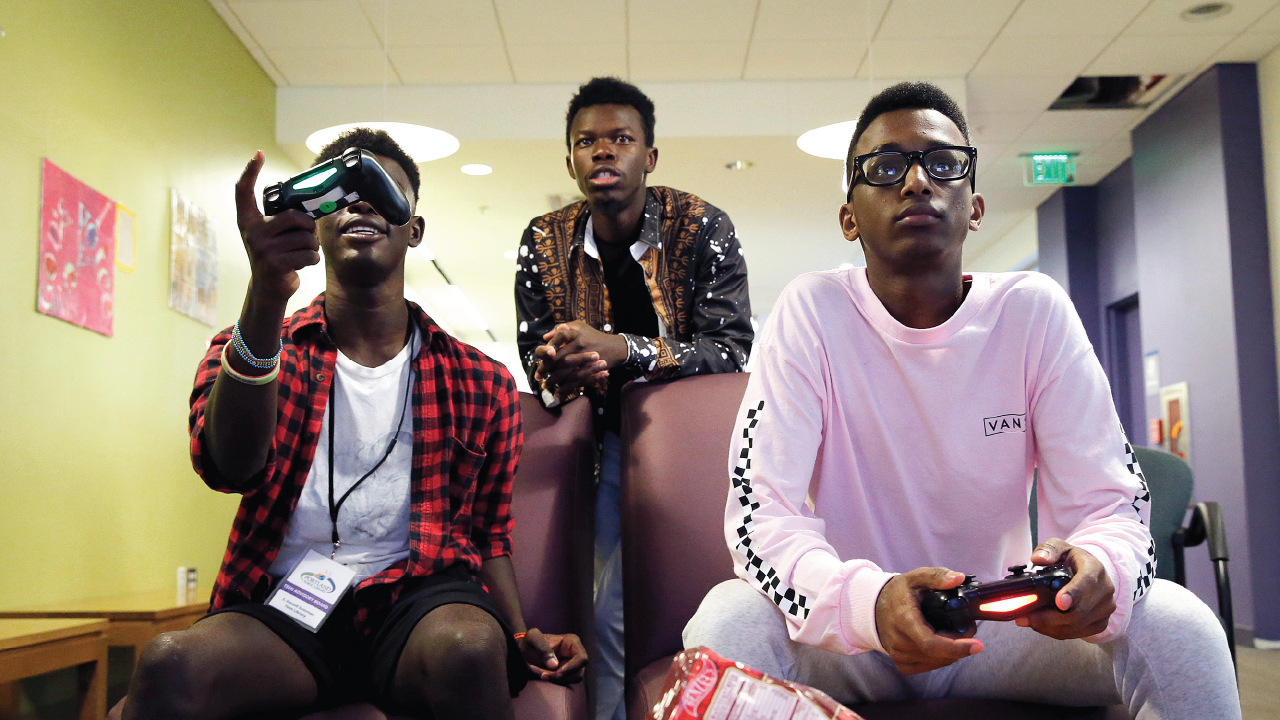
Pew Research Center conducted this analysis to better understand teens’ use of and experiences with video games.
The Center conducted an online survey of 1,453 U.S. teens from Sept. 26 to Oct. 23, 2023, through Ipsos. Ipsos recruited the teens via their parents, who were part of its KnowledgePanel . The KnowledgePanel is a probability-based web panel recruited primarily through national, random sampling of residential addresses. The survey was weighted to be representative of U.S. teens ages 13 to 17 who live with their parents by age, gender, race and ethnicity, household income, and other categories.
This research was reviewed and approved by an external institutional review board (IRB), Advarra, an independent committee of experts specializing in helping to protect the rights of research participants.
Here are the questions used for this analysis , along with responses, and its methodology .
There are long-standing debates about the impact of video games on youth. Some credit them for helping young people form friendships and teaching them about teamwork and problem-solving . Others say video games expose teenagers to violent content, negatively impact their sleep and can even lead to addiction.
With this in mind, Pew Research Center surveyed 1,423 U.S. teens ages 13 to 17 about their own video game habits – from how often they play to the friends they’ve made and whether it gets in the way of them doing well in school or getting a good night’s sleep. 1
Key findings from the survey
- Video games as a part of daily teen life: 85% of U.S. teens report playing video games, and 41% say they play them at least once a day. Four-in-ten identify as a gamer.
- Gaming as a social experience: 72% of teens who play video games say that a reason why they play them is to spend time with others. And some have even made a friend online from playing them – 47% of teen video game players say they’ve done this.
- Helpful with problem-solving, less so for sleep: Over half of teens who play video games say it has helped their problem-solving skills, but 41% also say it has hurt their sleep.
- Bullying is a problem: 80% of all teens think harassment over video games is a problem for people their age. And 41% of those who play them say they’ve been called an offensive name when playing.
- Boys’ and girls’ experiences differ: Most teen boys and girls play video games, but larger shares of boys identify as gamers (62% vs. 17%) and play every day (61% vs. 22%). Boys who play them are also more likely to experience positive things from it, like making friends, and more troubling things like harassment.
Jump to read about: Who plays video games | Socializing over video games | Views about video games’ impact | Harassment and violence in video games
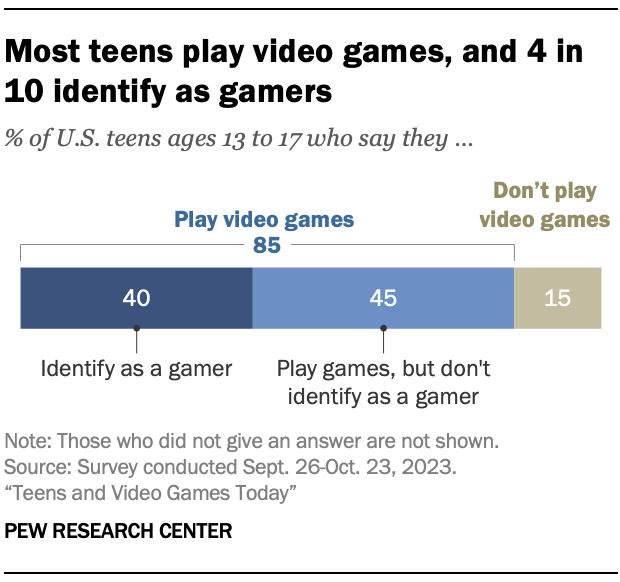
Playing video games is widespread among teens. The vast majority of U.S. teens (85%) say they play them. Just 15% say they never do, according to the survey conducted Sept. 26-Oct. 23, 2023.
In addition to asking whether teens play video games, we also wanted to learn whether they consider themselves gamers. Overall, four-in-ten U.S. teens think of themselves as gamers. Just under half of teens (45%) play video games but do not think of themselves as gamers.
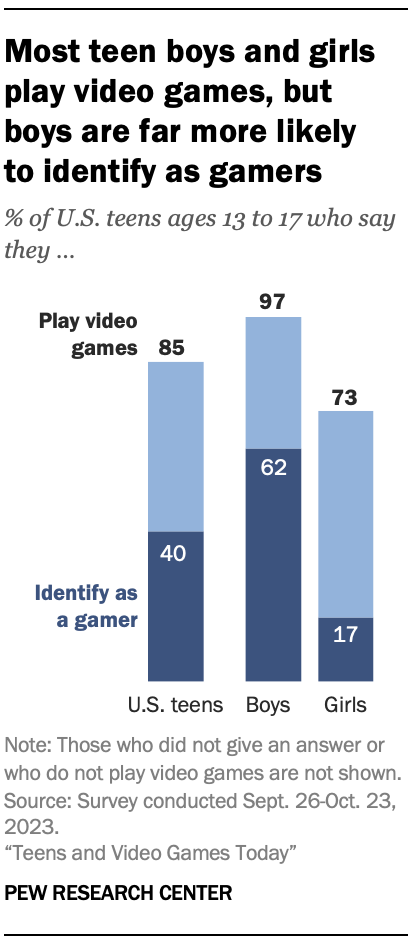
Nearly all boys (97%) say they play video games, compared with about three-quarters of teen girls. There is a substantial gap by gender in whether teens identify as gamers: 62% of teen boys do, compared with 17% of girls. 2
By gender and age
Younger teen girls are more likely than older girls to say they play video games: 81% of girls ages 13 to 14 compared with 67% of those ages 15 to 17. But among boys, nearly all play video games regardless of age.
Similar shares of teens play video games across different racial and ethnic groups and among those who live in households with different annual incomes. Go to Appendix A for more detail on which teens play video games and which teens identify as gamers.
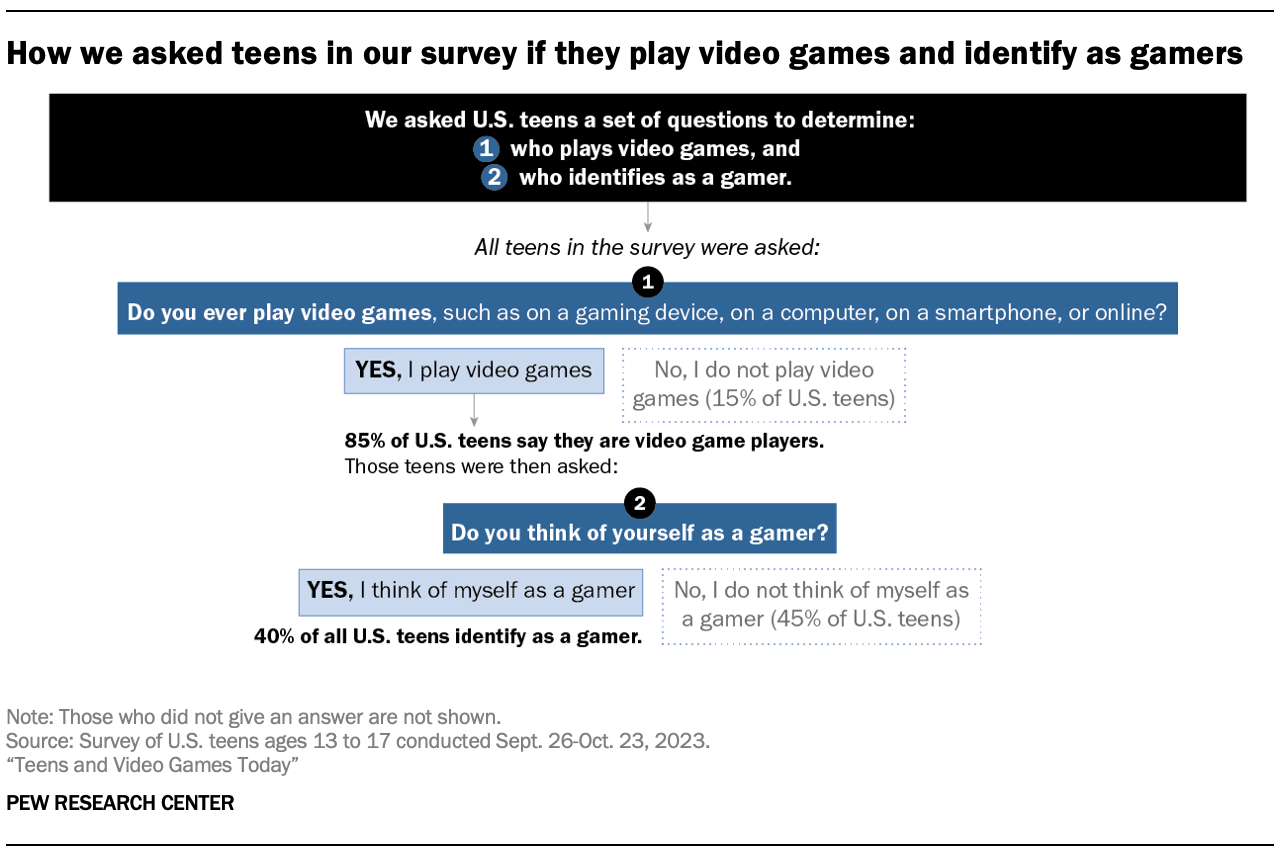
We also asked teens how often they play video games. About four-in-ten U.S. teens say they play video games daily, including 23% who do so several times a day.
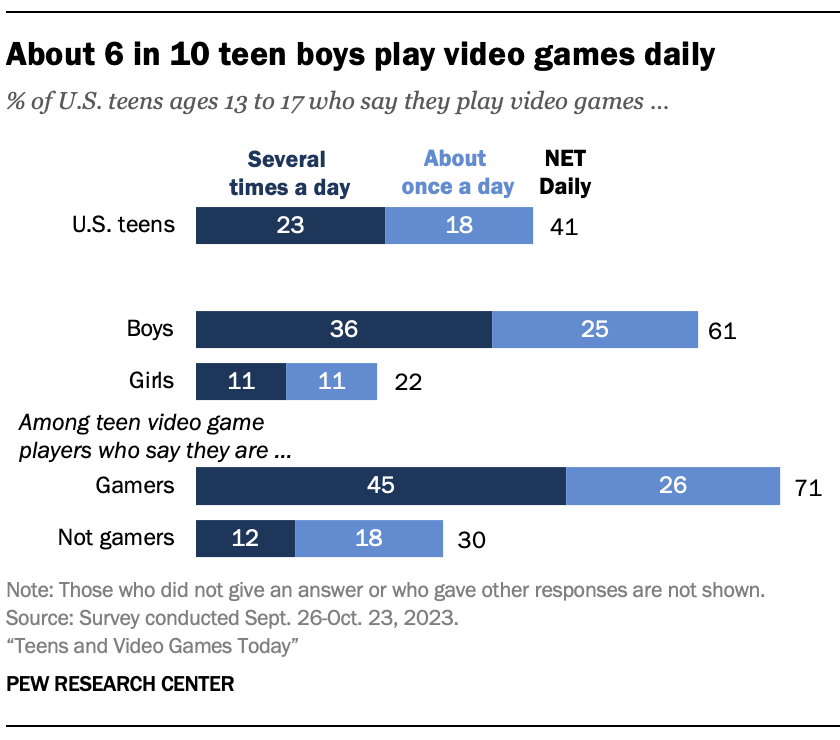
Another 22% say they play several times a week, while 21% play them about once a week or less.
Teen boys are far more likely than girls to say they play video games daily (61% vs. 22%). They are also much more likely to say they play them several times a day (36% vs. 11%).
By whether someone identifies as a gamer
About seven-in-ten teens who identify as gamers (71%) say they play video games daily. This drops to 30% among those who play them but aren’t gamers.
By household income
Roughly half of teens living in households with an annual income of less than $30,000 (53%) say they play video games at least daily. This is higher than those in households with an annual income of $30,000 to $74,999 (42%) and $75,000 or more (39%).
Go to Appendix A to see more details about who plays video games and identifies as a gamer by gender, age, race and ethnicity, and household income.
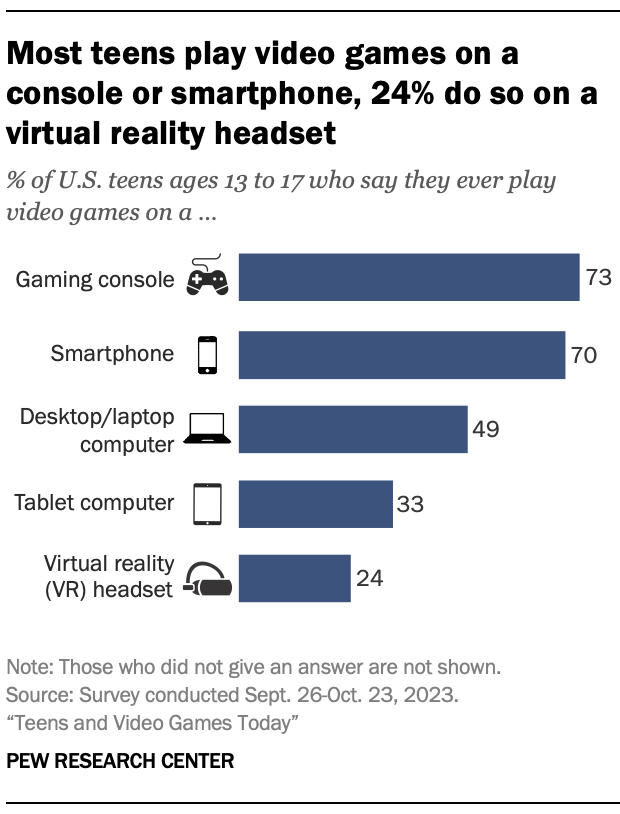
Most teens play video games on a gaming console or a smartphone. When asked about five devices, most teens report playing video games on a gaming console (73%), such as PlayStation, Switch or Xbox. And 70% do so on a smartphone. Fewer – though still sizable shares – play them on each of the following:
- 49% say they play them on a desktop or laptop computer
- 33% do so on a tablet
- 24% play them on a virtual reality (VR) headset such as Oculus, Meta Quest or PlayStation VR
Many teens play video games on multiple devices. About a quarter of teens (27%) do so on at least four of the five devices asked about, and about half (49%) play on two or three of them. Just 8% play video games on one device.
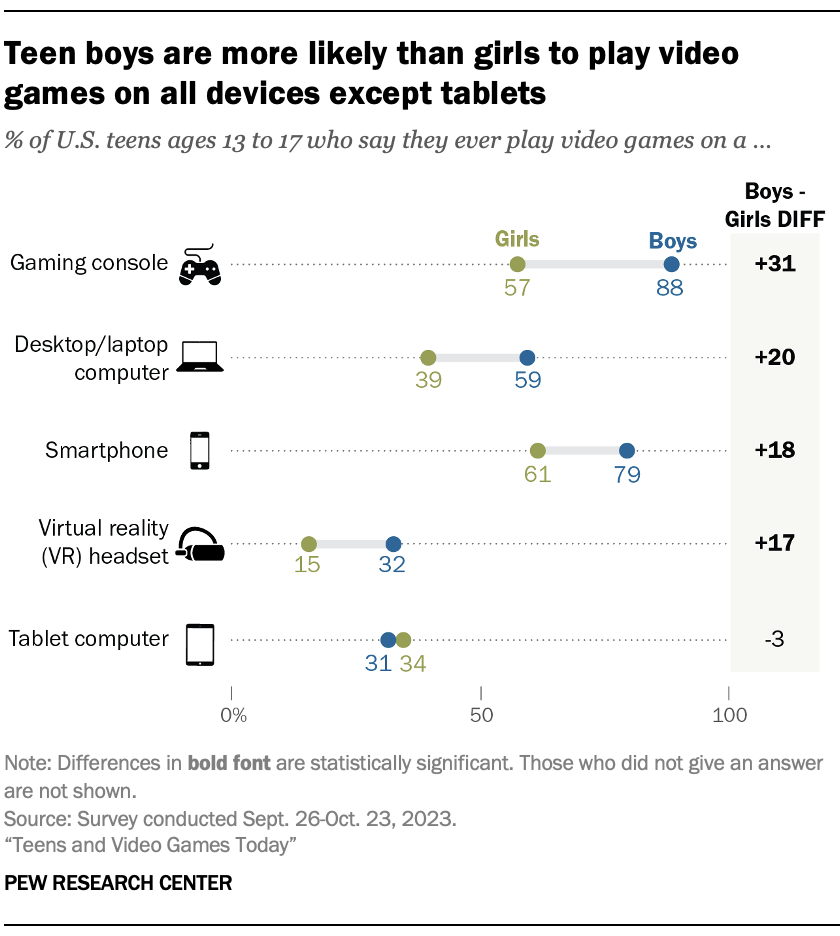
Teen boys are more likely than girls to play video games on four of the five devices asked about – all expect tablets. For instance, roughly nine-in-ten teen boys say they ever play video games on a gaming console, compared with 57% of girls. Equal shares of teen boys and girls play them on tablets.
Teens who consider themselves gamers are more likely than those who play video games but aren’t gamers to play on a gaming console (95% vs. 78%), desktop or laptop computer (72% vs. 45%) or a virtual reality (VR) headset (39% vs. 19%). Similar shares of both groups play them on smartphones and tablets.
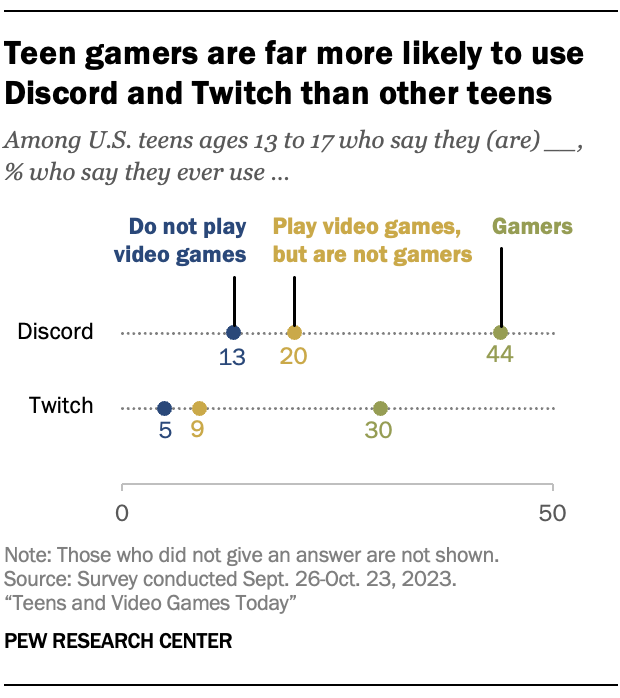
One way that teens engage with others about video games is through online platforms. And our survey findings show that teen gamers stand out for their use of two online platforms that are known for their gaming communities – Discord and Twitch :
- 44% of teen gamers say they use Discord, far higher than video game players who don’t identify as gamers or those who use the platform but do not play video games at all. About three-in-ten teens overall (28%) use Discord.
- 30% of teens gamers say they use Twitch. About one-in-ten other teens or fewer say the same; 17% of teens overall use the platform.
Previous Center research shows that U.S. teens use online platforms at high rates .
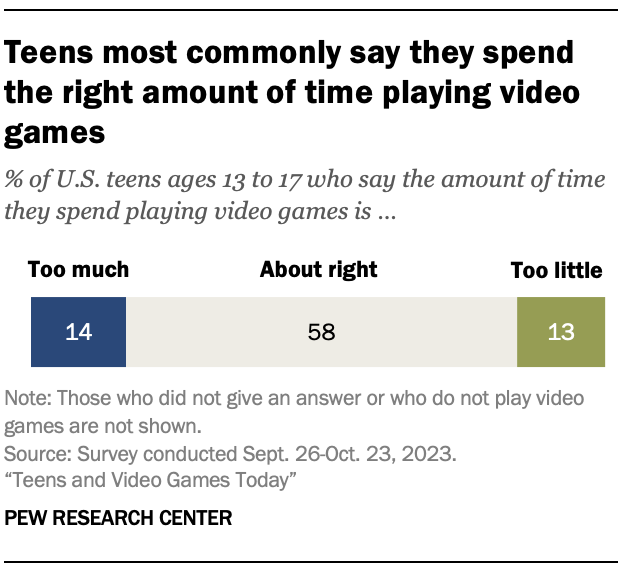
Teens largely say they spend the right amount of time playing video games. When asked about how much time they spend playing them, the largest share of teens (58%) say they spend the right amount of time. Far fewer feel they spend too much (14%) or too little (13%) time playing them.
Teen boys are more likely than girls to say they spend too much time playing video games (22% vs. 6%).
By race and ethnicity
Black (17%) and Hispanic (18%) teens are about twice as likely than White teens (8%) to say they spend too little time playing video games. 3
A quarter of teens who consider themselves gamers say they spend too much time playing video games, compared with 9% of those who play video games but don’t identify as gamers. Teen gamers are also less likely to think they spend too little time playing them (19% vs. 10%).
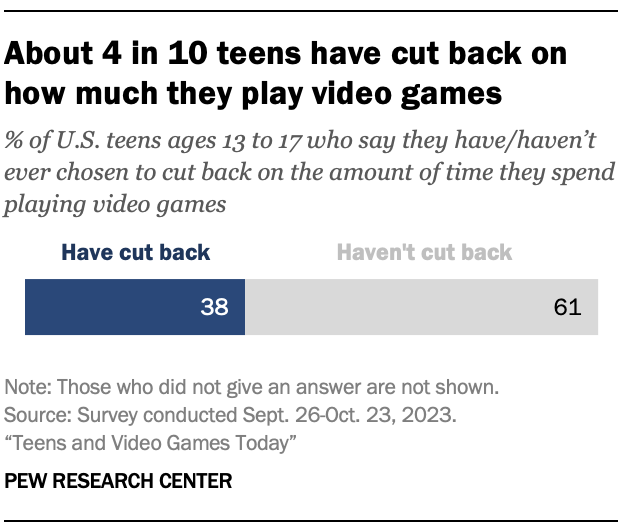
Fewer than half of teens have reduced how much they play video games. About four-in-ten (38%) say they have ever chosen to cut back on the amount of time they spend playing them. A majority (61%) report that they have not cut back at all.
This share is on par with findings about whether teenagers have cut back with their screen time – on social media or their smartphone.
Although boys are more likely to say they play video games too much, boys and girls are on par for whether they have ever cut back. About four-in-ten teen boys (39%) and girls (38%) say that they have ever cut back.
And gamers are as likely to say they have cut back as those who play video games but don’t identify as gamers (39% and 41%).
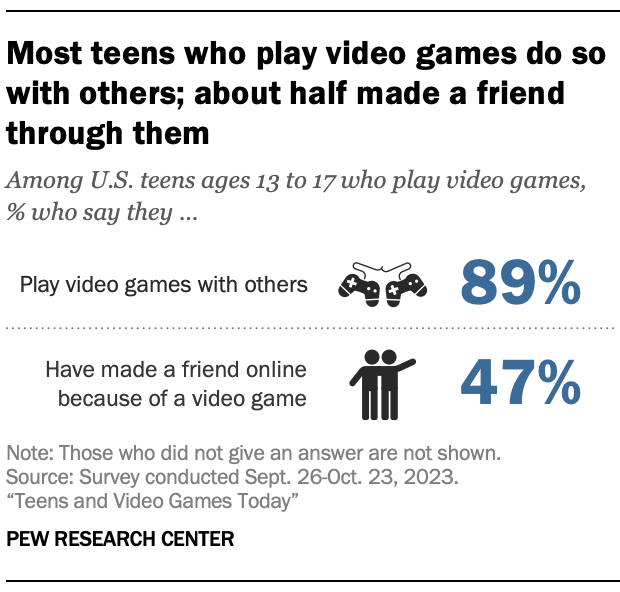
A main goal of our survey was to ask teens about their own experiences playing video games. For this section of the report, we focus on teens who say they play video games.
Socializing with others is a key part of the video game experience. Most teens who play video games do so with others, and some have developed friendships through them.
About nine-in-ten teen video game players (89%) say they play them with other people, in person or online. Far fewer (11%) play them only on their own.
Additionally, about half (47%) report that they have ever made a friend online because of a video game they both play. This equals 40% of all U.S. teens who have made a friend online because of a video game.
These experiences vary by:
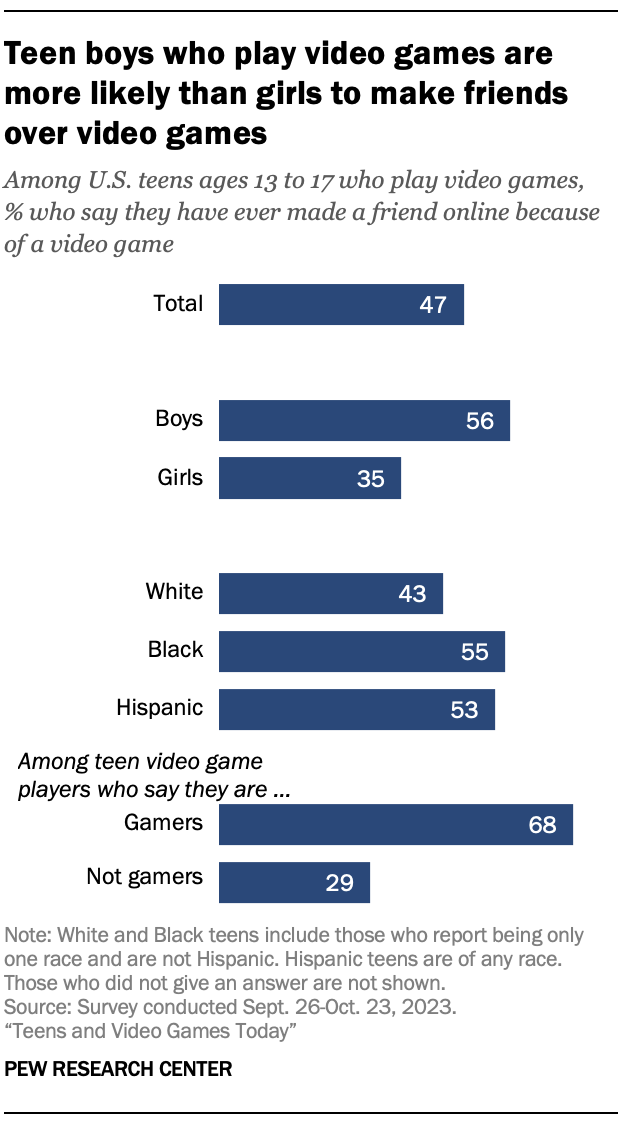
- Gender: Most teen boy and girl video game players play them with others, though it’s more common among boys (94% vs. 82%). Boys who play video games are much more likely to say they have made a friend online because of a video game (56% vs. 35%).
- Race and ethnicity: Black (55%) and Hispanic (53%) teen video game players are more likely than White teen video game players (43%) to say they have made a friend online because of them.
- Whether someone identifies as a gamer: Nearly all teen gamers report playing video games with others (98%). Fewer – though still most – of those who play video games but aren’t gamers (81%) also play them with others. And about seven-in-ten (68%) say they have made a friend online because of a video game, compared with 29% of those who play them but don’t identify as gamers.
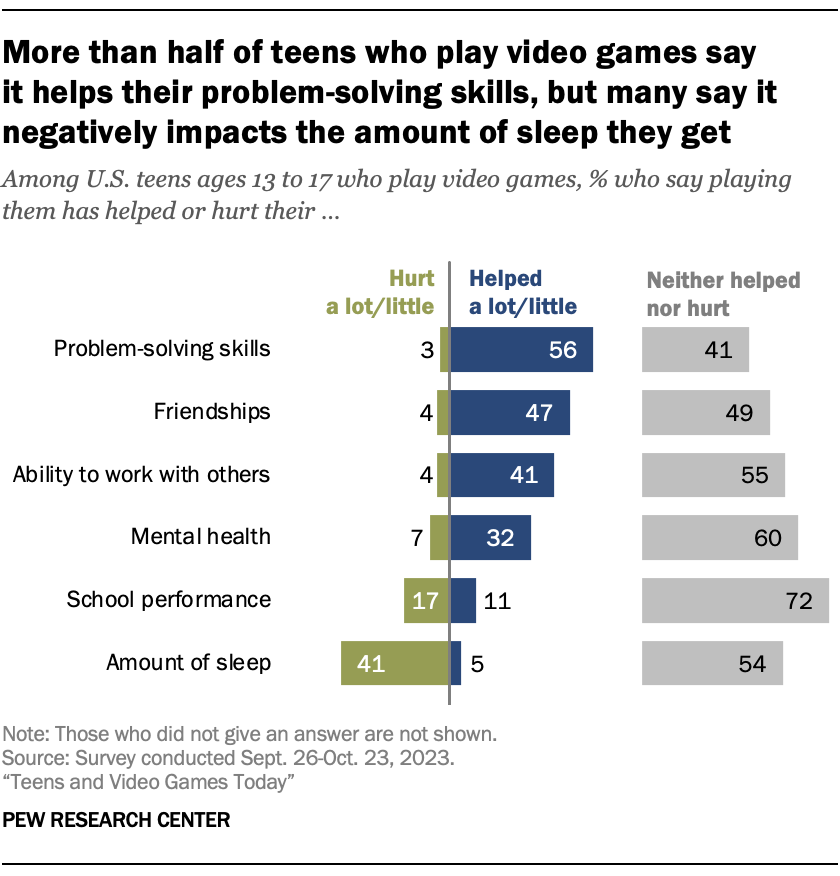
Teens who play video games are particularly likely to say video games help their problem-solving skills. More than half of teens who play video games (56%) say this.
Additionally, more think that video games help, rather than hurt, three other parts of their lives that the survey asked about. Among teens who play video games:
- Roughly half (47%) say it has helped their friendships
- 41% say it has helped how they work with others
- 32% say it has helped their mental health
No more than 7% say playing video games has hurt any of these.
More teens who play video games say it hurts, rather than helps, their sleep. Among these teens, 41% say it has hurt how much sleep they get, while just 5% say it helps. And small shares say playing video games has impacted how well they do in school in either a positive or a negative way.
Still, many teens who play video games think playing them doesn’t have much an impact in any of these areas. For instance, at least six-in-ten teens who play video games say it has neither a positive nor a negative impact on their mental health (60%) or their school performance (72%). Fewer (41%) say this of their problem-solving skills.
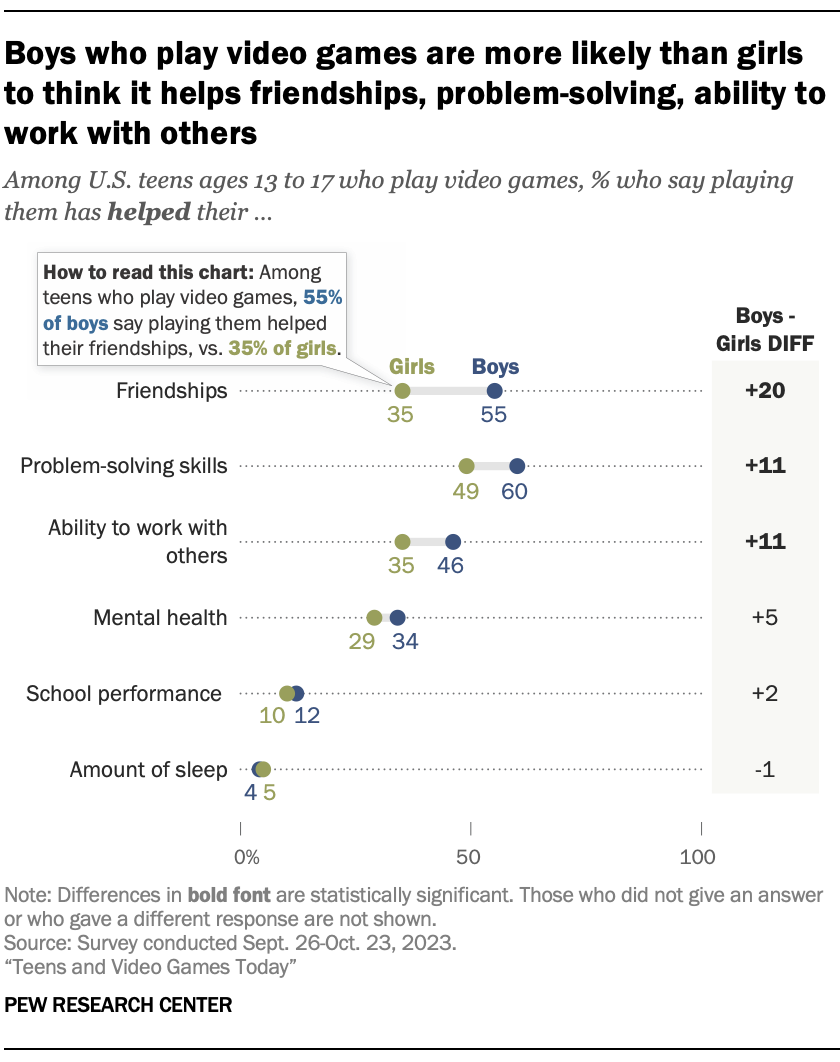
Teen boys who play video games are more likely than girls to think playing them has helped their problem-solving skills, friendships and ability to work with others. For instance, 55% of teen boys who play video games say this has helped their friendships, compared with 35% of teen girls.
As for ways that it may hurt their lives, boys who play them are more likely than girls to say that it has hurt the amount of sleep they get (45% vs. 37%) and how well they do in school (21% vs. 11%).
Teens who consider themselves gamers are more likely than those who aren’t gamers but play video games to say video games have helped their friendships (60% vs. 35%), ability to work with others (52% vs. 32%), problem-solving skills (66% vs. 47%) and mental health (41% vs. 24%).
Gamers, though, are somewhat more likely to say playing them hurt their sleep (48% vs. 36%) and how well they do in school (20% vs. 14%).
By whether teens play too much, too little or the right amount
Teens who report playing video games too much stand out for thinking video games have hurt their sleep and school performance. Two-thirds of these teens say it has hurt the amount of sleep they get, and 39% say it hurt their schoolwork. Far fewer of those who say they play the right amount (38%) or too little (32%) say it has hurt their sleep, or say it hurt their schoolwork (12% and 16%).
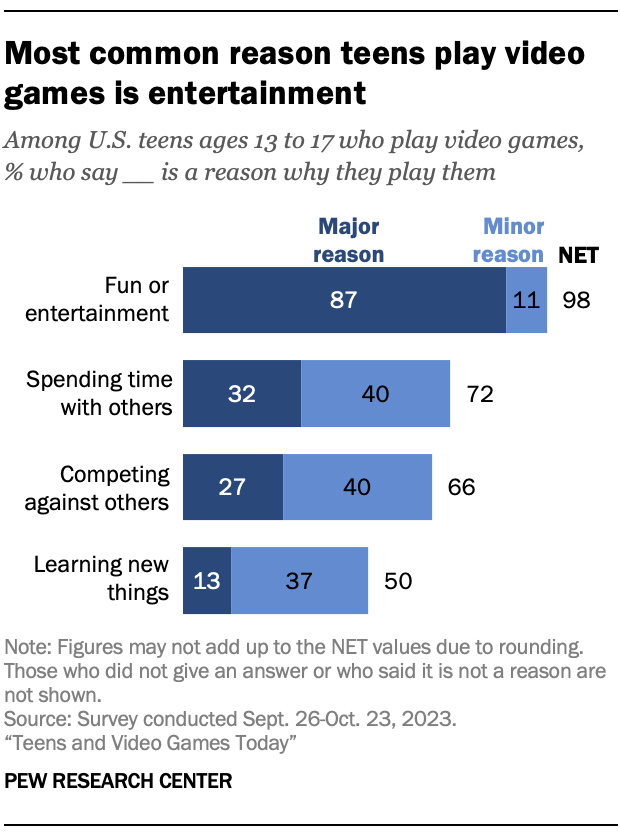
Teens who play video games say they largely do so to be entertained. And many also play them to be social with and interact with others. Teens who play video games were asked about four reasons why they play video games. Among those who play video games:
- Nearly all say fun or entertainment is a major or minor reason why they play video games – with a large majority (87%) saying it’s a major reason.
- Roughly three-quarters say spending time with others is a reason, and two-thirds say this of competing with others. Roughly three-in-ten say each is a major reason.
- Fewer – 50% – see learning something as a reason, with just 13% saying it’s a major reason.
While entertainment is by far the most common reason given by teens who play video games, differences emerge across groups in why they play video games.
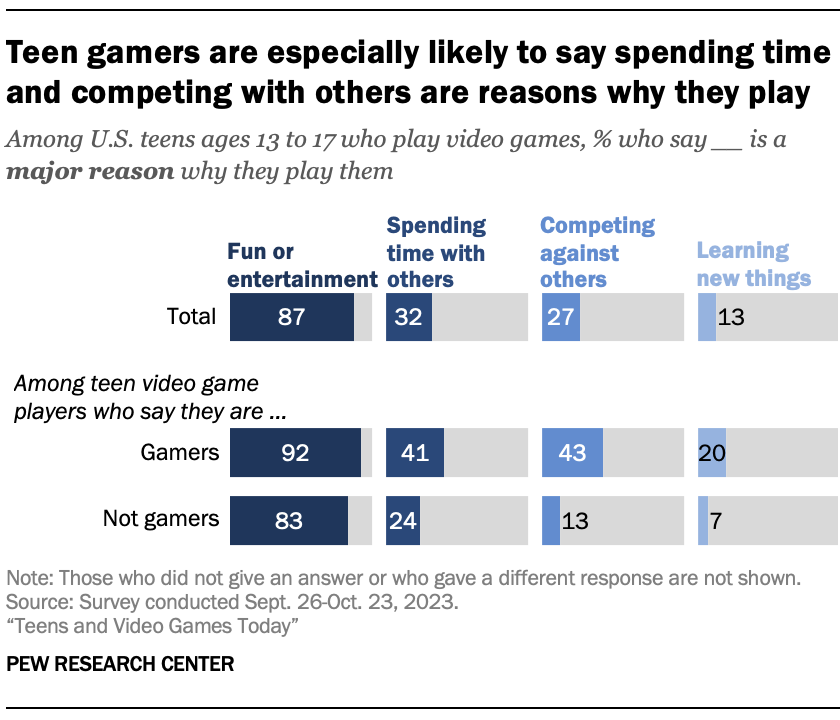
Teens who identify as gamers are particularly likely to say each is major reason, especially when it comes to competing against others. About four-in-ten gamers (43%) say this is a major reason, compared with 13% of those who play video games but aren’t gamers.
Teen boys who play video games are more likely than girls to say competing (36% vs. 15%), spending time with others (36% vs. 27%) and entertainment (90% vs. 83%) are major reasons they play video games.
Black and Hispanic teens who play video games are more likely than White teens to say that learning new things and competing against others are major reasons they play them. For instance, 29% of Black teen video game players say learning something new is a major reason, higher than 17% of Hispanic teen video game players. Both are higher than the 7% of White teen video game players who say the same.
Teens who play video games and live in lower-income households are especially likely to say competing against others and learning new things are major reasons. For instance, four-in-ten teen video game players who live in households with an annual income of less than $30,000 say competing against others is a major reason they play. This is higher than among those in households with annual incomes of $30,000 to $74,999 (29%) and $75,000 or more (23%).
Cyberbullying can happen in many online environments, but many teens encounter this in the video game world.
Our survey finds that name-calling is a relatively common feature of video game life – especially for boys. Roughly four-in-ten teen video game players (43%) say they have been harassed or bullied while playing a video game in one of three ways:
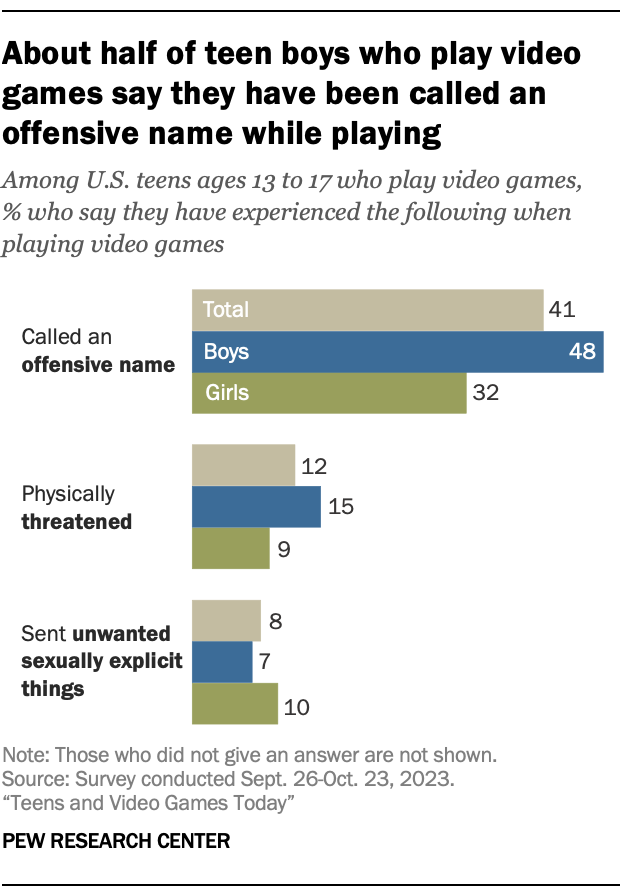
- 41% have been called an offensive name
- 12% have been physically threatened
- 8% have been sent unwanted sexually explicit things
Teen boys are particularly likely to say they have been called an offensive name. About half of teen boys who play video games (48%) say this has happened while playing them, compared with about a third of girls (32%). And they are somewhat more likely than girls to have been physically threatened (15% vs. 9%).
Teen gamers are more likely than those who play video games but aren’t gamers to say they been called and offensive name (53% vs. 30%), been physically threatened (17% vs. 8%) and sent unwanted sexually explicit things (10% vs. 6%).
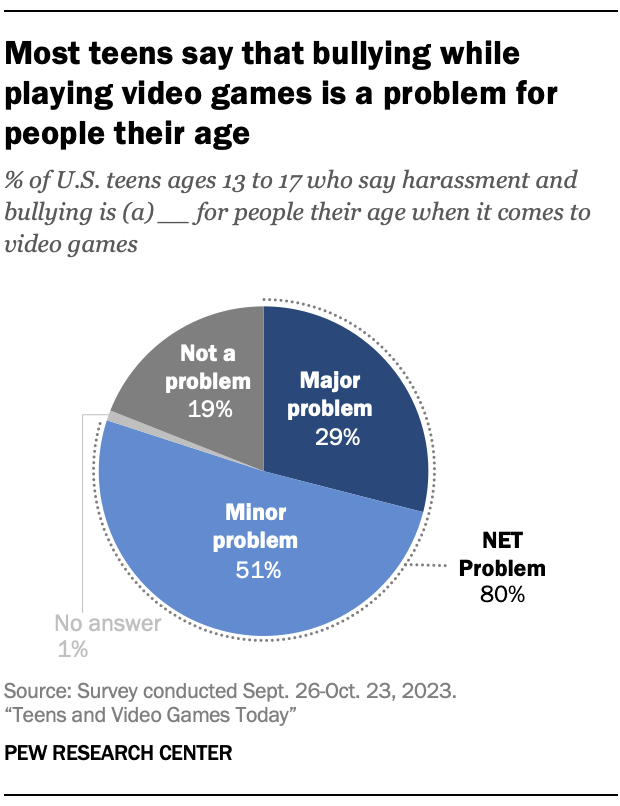
Teens – regardless of whether they’ve had these experiences – think bullying is a problem in gaming. Eight-in-ten U.S. teens say that when it comes to video games, harassment and bullying is a problem for people their age. This includes 29% who say it is a major problem.
It’s common for teens to think harassment while playing video games is a problem, but girls are somewhat more likely than boys to say it’s a major problem (33% vs. 25%).
There have also been decades-long debates about how violent video games can influence youth behavior , if at all – such as by encouraging or desensitizing them to violence. We wanted to get a sense of how commonly violence shows up in the video games teens are playing.
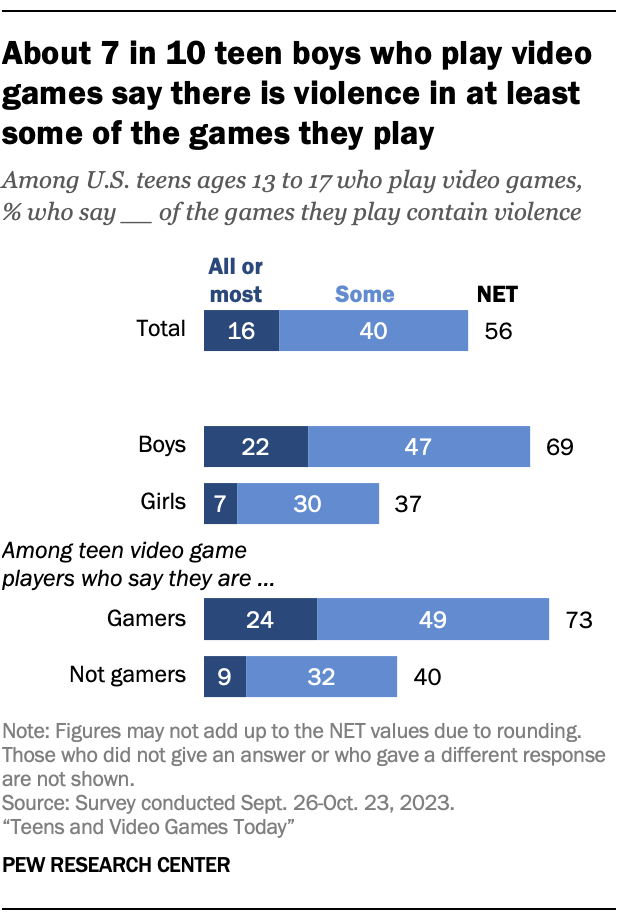
Just over half of teens who play video games (56%) say at least some of the games they play contain violence. This includes 16% who say it’s in all or most of the games they play.
Teen boys who play video games are far more likely than girls to say that at least some of the games they play contain violence (69% vs. 37%).
About three-quarters of teen gamers (73%) say that at least some of the games they play contain violence, compared with 40% among video game players who aren’t gamers.
- Throughout this report, “teens” refers to those ages 13 to 17. ↩
- Previous Center research of U.S. adults shows that men are more likely than women to identify as gamers – especially the youngest adults. ↩
- There were not enough Asian American respondents in the sample to be broken out into a separate analysis. As always, their responses are incorporated into the general population figures throughout the report. ↩
Sign up for our weekly newsletter
Fresh data delivery Saturday mornings
Sign up for The Briefing
Weekly updates on the world of news & information
- Friendships
- Online Harassment & Bullying
- Teens & Tech
- Teens & Youth
How Teens and Parents Approach Screen Time
Teens and internet, device access fact sheet, teens and social media fact sheet, teens, social media and technology 2023, what the data says about americans’ views of artificial intelligence, most popular, report materials.
1615 L St. NW, Suite 800 Washington, DC 20036 USA (+1) 202-419-4300 | Main (+1) 202-857-8562 | Fax (+1) 202-419-4372 | Media Inquiries
Research Topics
- Age & Generations
- Coronavirus (COVID-19)
- Economy & Work
- Family & Relationships
- Gender & LGBTQ
- Immigration & Migration
- International Affairs
- Internet & Technology
- Methodological Research
- News Habits & Media
- Non-U.S. Governments
- Other Topics
- Politics & Policy
- Race & Ethnicity
- Email Newsletters
ABOUT PEW RESEARCH CENTER Pew Research Center is a nonpartisan fact tank that informs the public about the issues, attitudes and trends shaping the world. It conducts public opinion polling, demographic research, media content analysis and other empirical social science research. Pew Research Center does not take policy positions. It is a subsidiary of The Pew Charitable Trusts .
Copyright 2024 Pew Research Center
Beijing can’t wish away China’s overcapacity problem

Good morning. Clay Chandler here, writing from Hong Kong. All year senior officials from the U.S. and Europe have sought—without success—to persuade counterparts in Beijing that China has an “overcapacity problem.”
In Beijing last month, U.S. Treasury Secretary Janet Yellen warned that President Joe Biden could not allow U.S. manufacturers to be “decimated” by a “flood” of “ artificially cheap Chinese products .” China’s foreign ministry bristled .
Two weeks later, the ministry rebuked Secretary of State Antony Blinken for using the O-word on his Beijing visit and accused the U.S. of “ hyping up a false narrative .”
Chinese President Xi Jinping dismissed the idea entirely when he met with French President Emmanuel Macron and European Commission President Ursula von der Leyen this week. There is “ no such thing as ‘China’s overcapacity problem,’” he said.
But the issue can’t be wished away.
Western leaders have focused their fears on solar panels, lithium batteries, and electric vehicles. China exported over $138 billion worth of such products last year, up 30% from 2022. Biden will reportedly impose additional tariffs on all three sectors next week.
In solar, China now accounts for 80% of global capacity . In 2023, China’s production capacity for finished solar modules soared to more than double what the world installed, forcing producers to slash prices. In Germany and the Netherlands, solar panels are so cheap they’re being used to build garden fences .
Similarly, China now makes 70% of the world’s lithium-ion batteries. Last year, Chinese exports jumped 28% to $65 billion.
But Western leaders are most worried about EVs. China exported 1.2 million “new energy” vehicles last year, making it the world’s largest exporter of cars . Hardly any of those vehicles were sold in the U.S. thanks to a 25% tariff. But in the EU, where the tariff is 10%, China’s EV market share tops 8% and could reach 20% by 2027. EU regulators may call for higher duties. The Rhodium Group, a research firm, estimates Chinese EVs would still be “highly attractive” to European buyers at a tariff of 30%.
Chinese officials maintain China’s green energy companies export so much because they’re so efficient. Sure, China has provided state support for clean energy companies—but the U.S. and Europe do that too. Besides, many argue, China’s clean energy expansion is helping the world meet critical sustainability goals and should be celebrated, not feared.
In Foreign Affairs , Rhodium’s Daniel Rosen and Logan Wright contend those arguments miss the larger point: China’s economy has stalled, and instead of prioritizing domestic demand, Beijing continues to prop up Chinese companies and encourage them to ship excess production overseas. The essay’s grim conclusion: China, Europe, and the U.S. are locked “on a dangerous course of trade confrontation in 2024, with a high probability of trade defense actions.”
More news below.
Clay Chandler [email protected]
More Boeing whistleblowers
The death of two Boeing whistleblowers is prompting more employees to come forward with concerns. “More than ten whistleblowers who are our clients from Boeing, Spirit and another supplier besides Spirit will speak up in the near future,” says Brian Knowles, the attorney who represented both John Barnett and Joshua Dean . This week, a new whistleblower from Spirit AeroSystems came forward , alleging that the Boeing supplier regularly shipped fuselages with defective parts. Fortune
Yapping at the office
Older employees and managers may grumble at younger workers’ tendency to talk incessantly at the office, but experts say they should get used to it. After years stuck at home, younger employees “haven’t had the chance to actually learn and have that give-and-take in work relationships,” says John Hackston, head of thought leadership at Myers-Brigg Company. And Gen Z’s penchant for yapping may be good for office culture, helping spark new ideas and foster a sense of belonging. Fortune
Why vets are getting more expensive
Pet health care is getting more expensive, with the price of veterinary care rising 32% over the past four years. Some point to the entry of private equity firms, which started snapping up vet clinics in 2020 and now own around 30% of the market. The rising cost of care is pushing owners to give up their pets: Almost 2 million animals were surrendered to shelters in 2023. Fortune
AROUND THE WATERCOOLER
TikTok will automatically label AI-generated posts using Adobe’s Content Credentials by Sharon Goldman
Google employees grill Sundar Pichai and CFO Ruth Porat on why they’re not getting pay rises amid blowout earnings by Eleanor Pringle
‘Housing has hit rock bottom’: Top real estate CEO says high home prices are shutting people out of the market by Alena Botros
Amid Tesla’s bloodletting, top exec sends Musk a message: The company has ‘taken its pound of flesh’ by Amanda Gerut
Commentary: I’m the CTO of Canada’s biggest airport. AI isn’t destroying jobs in aviation—it’s giving us superpowers to improve air travel by Brian Tossan
Even after cramming its video game with Walmart ads and billboards, Roblox struggles to tap into the wallets of extremely online Gen Alpha by Sasha Rogelberg
T his edition of CEO Daily was curated by Nicholas Gordon.
Latest in Newsletters

Top consultant Josh Bersin says HR leaders are at a pivotal moment and should rethink their role in the corporate world

Why crypto VCs are fretting about distributions: ‘Let them see the green’

The CFOs of Prudential, TD Securities, and Zoetis on how their roles have evolved: ‘You’re in the middle of everything’

Microsoft CEO Satya Nadella is facing the AI arms race with urgency—and maybe a little paranoia

The Mooch, Andrew Yang, and crypto’s tipping point

AI music may be having a moment, but human songwriters would like a word
Most popular.

France admits it’s lost control of parts of New Caledonia, the world’s third-largest producer of critical EV metal nickel

Why can’t America have high speed rail? Because our investment is a ‘rounding error’ compared with Europe’s, says Amtrak’s CEO

Thousands of North Koreans stole Americans’ identities and took remote-work tech jobs at Fortune 500 companies, DOJ says

Amazon raised warehouse wages to $15 an hour 5 years ago. Today, half of workers surveyed told researchers they struggle to afford food or rent

Consumers are so demoralized by inflation and high rates that they’ve given up on saving for the American Dream and are spending money instead, economist says

Texas power prices briefly soar 1,600% as a spring heat wave is expected to drive record demand for energy

IMAGES
VIDEO
COMMENTS
Practice is crucial to maths success, and our questions are designed to support your daily routines. These problems can be used across Y1 and Y2 throughout the year. Download. Our maths problems of the day provide four problems across KS1, KS2 and Lower KS3 for pupils to solve. View our Maths resources from White Rose Maths.
Years 3 to 6. Six weeks of daily reasoning and problem-solving questions for Years 3, 4, 5 AND 6! (Totalling approximately 360 reasoning questions!) Mapped to a progression document for each of the four KS2 year groups; Use in conjunction with daily arithmetic practice from Fluent in Five; An excellent and simple resource for daily classroom use!
Discover how numbers can be connected in a pattern and see if you can solve the puzzle. Find out how partitioning a number can help you solve tricky maths problems. KS2 Maths Problem solving ...
Free problem solving maths games for KS2 children. Topmarks Search; Whiteboard Resources; Learning Games; Topmarks Apps; Topmarks Blog; Share this page: 3-5 Years; 5-7 Years; 7-11 Years; ... Problem Solving Games. These resources provide fun, free problem solving teaching ideas and activities for primary aged children. They will help children ...
This practice and problem-solving workbook allows children to focus on a daily number. The worksheets encourage pupils to solve a range of maths problems, including but not limited to spelling the number, finding 100 more, subtracting fractions, and finding a percentage. All of our resources are made by and with the help of experienced teachers ...
Adding Time Word Problems. Word problems where you need to read the time on either an analogue or digital clock and then answer a word problem involving adding a given time. A selection of excellent primary resources which work well on interactive whiteboards in the classroom.
Find out how we encourage children to approach problem solving independently in our blog: 20 Maths Strategies KS2 That Guarantee Progress for All Pupils. The most commonly used model is that of George Polya (1973), who proposed 4 stages in problem solving, namely: Understand the problem. Devise a strategy for solving it.
Tackle challenging questions using a variety of mathematical skills with our range of problem-solving maths resources, designed for KS2 students. Problem-solving in KS2 is a key skill that will form the foundation of future learning. That's why we've designed some brilliant PowerPoints, worksheets, games, and lots of maths mastery resources to ...
Help your kids learn and practice the ability to calculate, reason and solve problems effectively with our selection of maths problem-solving KS2 primary resources, ideas, activities and games for Year 5 and Year 6 children. These activities aimed at maths problem-solving for kids, will allow students to apply their maths knowledge and skills ...
Here, we've compiled 25 maths problems, puzzles, problem solving questions and more. Maths Tutoring for Schools. National Tutoring Programme ... FREE daily maths challenges . A new KS2 maths challenge every day. Perfect as lesson starters - no prep required! ... View today's challenge . Contents. Maths Mastery 25 Fun Maths Problems For KS2 And ...
Migration KS2 - Use news reports to explore vocab and stats. Negative numbers worksheet - Teaching negative numbers in KS2. Fractions of amounts worksheet - For KS2, including bar models. Equivalent fractions worksheet - Practice and problems for KS2. Tarsia puzzle - Equivalent fractions for KS2 maths. The NRICH maths team explains ...
Problem Solving. This feature is somewhat larger than our usual features, but that is because it is packed with resources to help you develop a problem-solving approach to the teaching and learning of mathematics. Read Lynne's article which discusses the place of problem solving in the new curriculum and sets the scene.
Short problems for Starters, Homework and Assessment. The links below take you to a selection of short problems based on UKMT junior and intermediate mathematical challenge questions. We have chosen these problems because they are ideal for consolidating and assessing subject knowledge, mathematical thinking and problem-solving skills.
I See Problem-Solving - UKS2 Sample provides 5 free sample tasks. For each task there is a main question, a support prompt and explain and extend features to deepen the challenge. The worked examples model the solutions to the main tasks step-by-step - download below for free.The 58 tasks span all areas of the UKS2 maths curriculum. The purchase price is £30 (£25 + £5 VAT) for the PDF ...
In this comprehensive KS2 maths challenges area, you will find worksheets, word problems and more - ideal for easy, difficult or intermediate maths challenges. ... KS2 Daily Maths Practice Worksheet. 5.0 (3 reviews) ... Problem-Solving Challenge Cards [Ages 9-11] 5.0 (5 reviews) Harry Potter: Problem-Solving Challenge Cards [Ages 7-9] ...
These fun Maths challenges are great for engaging KS2 maths students in a variety of topics and encouraging both in-class discussion and individual development. Find challenge cards, games and problem-solving tasks that are perfect for taking your lessons to new levels of depth.
This page has been superseded by our Working Systematically - Primary Teachers page. Scroll down to see our complete collection of KS2 problems that require children to work systematically, or explore the two sub-collections focusing on important aspects of systematic working. This collection is one of our Primary Curriculum collections - tasks ...
3. KS2 Maths Investigations Give Early Exposure To SATs Style, Reasoning Questions. Most, if not all, schools will provide their pupils with exposure to reasoning via SATs-style questions, but this often comes hand in hand with exams and assessment. Yet, it is equally important to get pupils reasoning and problem solving in a low stakes ...
Third Space Learning Frazer House, 32-38 Leman Street, 0203 771 0095. [email protected]
The steps are: Understanding the problem. Devising a plan. Carrying out the plan. Looking back and reflecting. Polya's process was something I wanted to introduce to my class, and so I taught this way of thinking about a problem over a term. The results were surprising and long-lasting, with four key takeaway points.
Problem solving in a real life context provides a stimulus for practical activities. ... Maths KS2: Problem solving with money. Problem solving with money is explored as Abi Measure saves up to ...
Approaching a conversation about improving an employee's performance requires preparation, empathy, and a focus on collaboration. Even though hearing the truth about their current performance ...
Our quick mental maths starters for KS2 are the ideal way to get little minds thinking first thing in the morning. They're great for engaging your class as soon as they enter a classroom and will ensure that they can focus on the main topic of the lesson. They're a fantastic way to keep children motivated too, particularly in the run-up to ...
University of Bonn. (2024, May 15). Wavefunction matching for solving quantum many-body problems. ScienceDaily. Retrieved May 16, 2024 from www.sciencedaily.com / releases / 2024 / 05 ...
FREE daily maths challenges . A new KS2 maths challenge every day. Perfect as lesson starters - no prep required! View today's challenge ... of addition and subtraction worksheets cover all KS2 year groups and cover a wide range of skills such as word problem solving, missing number patterns, mental maths, addition of 2, 3, 4 and more digit ...
Elections in India and Mexico offer some of the "greatest potential for business growth," says Ian Bremmer, Eurasia Group CEO. Leigh Vogel—Getty Images for Concordia Summit Good morning, For ...
There are long-standing debates about the impact of video games on youth. Some credit them for helping young people form friendships and teaching them about teamwork and problem-solving.Others say video games expose teenagers to violent content, negatively impact their sleep and can even lead to addiction.. With this in mind, Pew Research Center surveyed 1,423 U.S. teens ages 13 to 17 about ...
What it is: A site that promotes problem solving over worksheets, allowing children to work in a more practical manner. 17. Daily Rigour Articles. What it is: This is a free newspaper that puts maths problems into a real life context. It is full of interesting ideas to get children using challenge! 18. Total Maths
Similarly, China now makes 70% of the world's lithium-ion batteries. Last year, Chinese exports jumped 28% to $65 billion. But Western leaders are most worried about EVs. China exported 1.2 ...